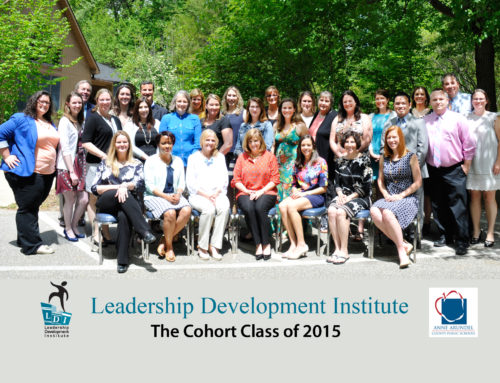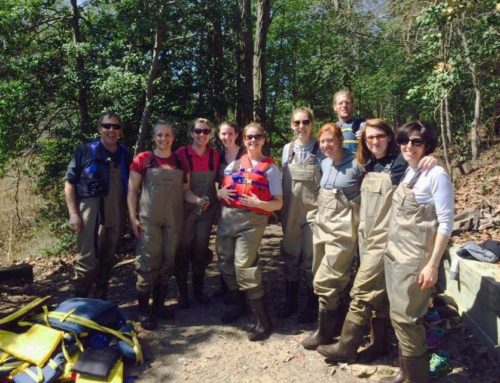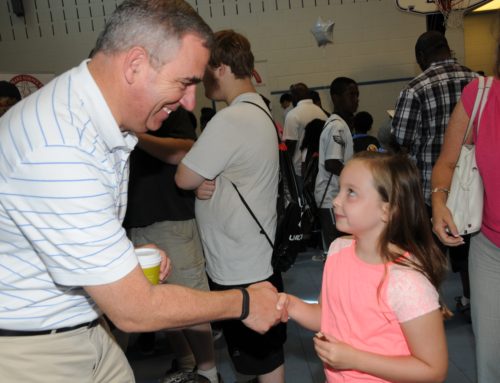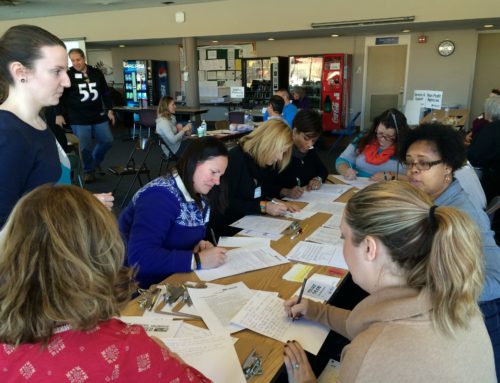Exploring the Role of the Arts in Education and Culture
November 14 & 15, 2014
I am a huge fan of Arts Integration (AI). During my time in the Division of Advanced Studies and Programs, I learned a lot about AI and the benefits these strategies can have in the classroom. So when I saw that this weeks’ LDI session was based on Arts Education & Culture, I was on board. What surprised me, however, what how arts integration could help me understand leadership and myself.
We met on Friday at Bates Middle School, one of eight Arts Integrated schools in the county and the first to offer AI as a full-school model. We spent the evening with Pat Klos, our AI specialist. Ms. Klos not only provided a context for arts integration within AACPS, but challenged us to practice some AI strategies ourselves.
In 2009, our county was awarded an Arts in Education Model Development and Dissemination grant to fund the development and implementation of a full-school AI model at Bates Middle School. This project, entitled Supporting Arts Integrated Learning for Student Success (SAILSS), was successful in significantly helping to turn around what had been a low-achieving school, better engage the community, and improve the overall climate of the school. Following in Bates’ successful footprints, AACPS’ full-school AI program model has been expanded to Brooklyn Park Middle School as well as Arnold, Crofton Woods, Germantown, Lake Shore, Rivera Beach, and Seven Oaks elementary schools. That, of course, is in addition to the many teachers who have been trained across the county to integrate AI strategies within their individual classrooms.
But what is AI? Arts Integration is the use of an artistic medium—visual arts, music, dance, theatre—to enhance learning and understanding of all content areas; it is learning about, with, and through the arts. From using a painting to spark discussions on the Industrial Revolution to incorporating element of dance to demonstrate planetary movement, AI strategies can be used to further any lesson. (When highlighting Bates as a School that Works, Edutopia put together a great video about their AI program that you can check out here).
That evening we practiced several common Artful Thinking strategies from I See/I Think/I Wonder to Beginning/Middle/End. One of the first strategies we practiced was a variation of What Makes You Say That? We heard a piece of music and were asked: What do you hear? What do you think? What makes you say that? Without knowing the title of the piece (later learned to be The Ballet of the Unhatched Chicks), we heard the quick pace of the melody and high tunes from woodwinds and flutes. From the accelerando of the music we imagined a chase scene and thought of bouncing because of the short and quick movement between high and low notes. In the span of five minutes we had used critical thinking to draw conclusions and defend those conclusions by citing specific examples from the musical “text”—all required common core strategies.
Pushing everyone out of their comfort zone, Ms. Klos also asked us to use dance to demonstrate the water cycle. After breaking into groups (Condensation represent!), we created a four-part routine that conveyed our individual part of the cycle. Within 10 minutes we collaborated with our team to present a “summary” to the class in a way that was engaging both for the performer and the audience.
For many in the LDI class, these activities mirrored what they did on a regular basis in their classrooms. Kim, who hosted the evening in her own Bates classroom, said that because there were no right or wrong answers, students who rarely participated would volunteer in these non-threatening AI activities. Others appreciated the way in which AI forced students to slow down their thinking by continually asking them to defend their conclusions with examples using both what they saw or heard and from prior knowledge of the subject matter. All-in-all, the evening validated the power of AI within the classroom.
So Friday left us with an understanding of how Arts Integration can help students. But how about us as leaders? How can we use the arts to think about our own experiences and engage with those around us?
We met at the Chesapeake Arts Center bright and early Saturday morning where we were greeted by Rob Levit. Mr. Levit is a local artist who has spent the past six years as an Artist-In-Residence at the Maryland Hall for the Creative Arts working with students and teachers at Bates and other schools around the county. More recently, Mr. Levit has turned his focus to adults, using his talents with music, art, and writing to provide arts integrated professional development. From 9:00 to noon, Mr. Levit took us through a series of activities that used different mediums to help us share information about our past, consider creative solutions for our workplace, and discuss the challenges we face as leaders.
If I had to choose one word to describe that morning the best I could do would be inspired. Mr. Levit’s friendly and honest personality made him an easy confidant for each of us to share struggles that we have faced in our jobs and with our students and coworkers. I am lucky that it is not the nature of this blog to provide a play-by-play of the day because when I think back over those three hours it is difficult to get at the essence of what made the day so engaging.
Of all of the activities, one that stood out to me the most was our discussion of leadership. During a lull in the class, Mr. Levit took out a box of musical instruments and silently began handing an instrument to each person and guiding that person into a circle, demonstrating the rhythm he wanted them to play. As everyone joined the circle, there were some who tried to start their own beat but Mr. Levit silently guided them back to the original rhythm until everyone joined the circle. He then indicated a new “leader” to start a new beat. For several silent minutes, the lead passed from one person to the next, each guiding the group through their own rhythm. The activity was actually incredibly simple, but in the discussion that followed we were able to name over ten different aspects of leadership that were exhibited in the exercise. We discussed the need to guide others to succeed, not just give instructions (showing each person how to use the instrument and staying with them until s/he matched the original beat); the importance of acknowledging other’s ideas and giving those around you a chance to lead as well (recognizing the desires of some to start their own beat [*cough* Pat *cough*] and ultimately moving aside to let that person lead); and the unique skills that everyone can contribute to a group (that everyone had a different instrument but was still part of the group melody).
As we considered ourselves as leaders, Mr. Levit stressed the importance of staying true to what matters most to each of us. Through all aspects of our job, each person has one to three things that drive them. Whatever those things are—helping kids, providing for our families, creating art—these needs are what matter most in our lives and so should be what drives us to do our jobs every day. When we die, we will look back at our own lives and measure success by how well we were able to live by the things that mattered to us most. Mr. Levit said that we are 100% responsible for our environment and in many ways he is right—it is our choice to work for this school system and if our job is not allowing us to meet our personal needs, then we are responsible for making a change. Otherwise we are only hurting ourselves and, ultimately, our students.
While this is the message that has stuck with me the most since that session, I think it is safe to assume that when we left that studio we walked away with 30 different moments of self-realization. It is refreshing to remember that while we are in LDI as a team, we are first and foremost there to both better and better understand ourselves. Now isn’t that deep for a Saturday morning?
I know this post is getting long, but I want to leave you with the Prayer of Techumseh, a Shawnee Chief, which I think poetically sums up all of the feelings that we were able to share with Mr. Levit that morning. Our class read this together at the end of our session and I hope that you are able to take something away from it as well:
“So live your life that the fear of death can never enter your heart.
Trouble no one about their religion; respect others in their view, and
Demand that they respect yours. Love your life, perfect your life,
Beautify all things in your life. Seek to make your life long and
Its purpose in the service of your people.
Prepare a noble death song for the day when you go over the great divide.
Always give a word or a sign of salute when meeting or passing a friend,
Even a stranger, when in a lonely place. Show respect to all people and
Bow to none. When you arise in the morning, give thanks for the food and
For the joy of living. If you see no reason for giving thanks,
The fault lies only in yourself. Abuse no one and nothing,
For abuse turns the wise ones to fools and robs the spirit of its vision.
When it comes your time to die, be not like those whose hearts
Are filled with fear of death, so that when their time comes
They weep and pray for a little more time to live their lives over again
In a different way. Sing your death song and die like a hero going home.”






